The Growth of Variable Speed Pumping
The Hydraulic Institute and Europump collaborated on the publication of Application Guideline for Variable Speed Pumping, which assists VSP end users and system integrators in the proper selection, specification, installation, control and operation of VSP equipment.
Category: Blogs December 7, 2022
by Peter Gaydon, Deputy Executive Director
Progress made in VSP technology, coupled with improved industry knowledge and recent government regulations on pumps, make VSP more relevant and accessible today than ever before. However, some special requirements must be understood to ensure that VSP is used in the right applications and that reliability issues do not occur. Industry and user knowledge has improved, but it remains difficult to find objective literature that has information directed toward these special requirements with an emphasis on the pumping industry. The Hydraulic Institute and Europump collaborated on the publication of Application Guideline for Variable Speed Pumping, which assists VSP end users and system integrators in the proper selection, specification, installation, control and operation of VSP equipment.
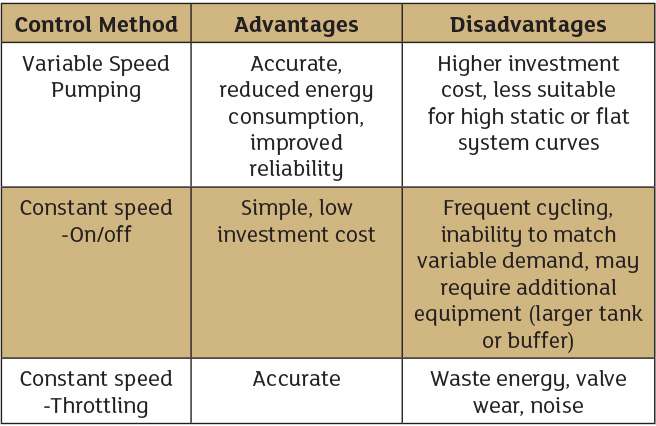
There are advantages and disadvantages to all pump control methods, and Table 1 provides information on four common pump control methods. The advantage of VSP and disadvantage of throttling and bypass control noted in the table reminds us that VSP is the most effective way to improve overall system efficiency, by eliminating throttling or bypassing of flow. VSP can provide additional energy savings when used in combination with on/off control and some storage capacity. This is done by optimizing the pump speed to the minimum specific energy (Es) requirement. Es is not necessarily familiar to all pump users, but it is a simple concept to understand. It is the ratio of energy used and pumped volume as shown in Equation 1. When using on/off control with VSP, users can optimize the system to operate at the minimum Es rather than operating the pump at full speed for short periods of time. In addition, this allows the pump to operate for longer periods of time, which reduces pump cycling and resulting maintenance issues.

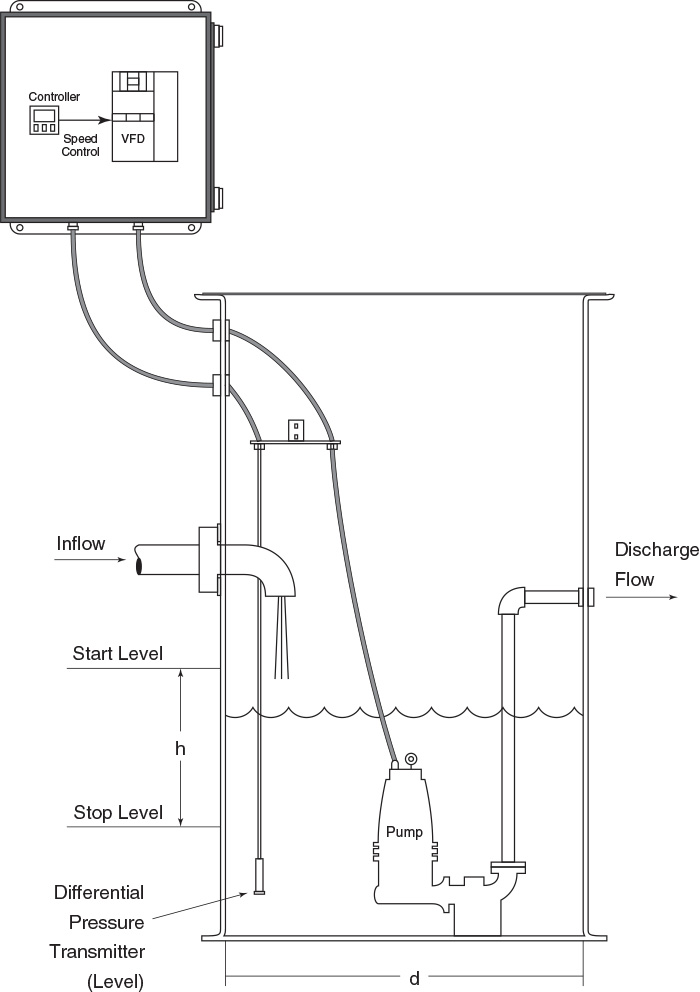
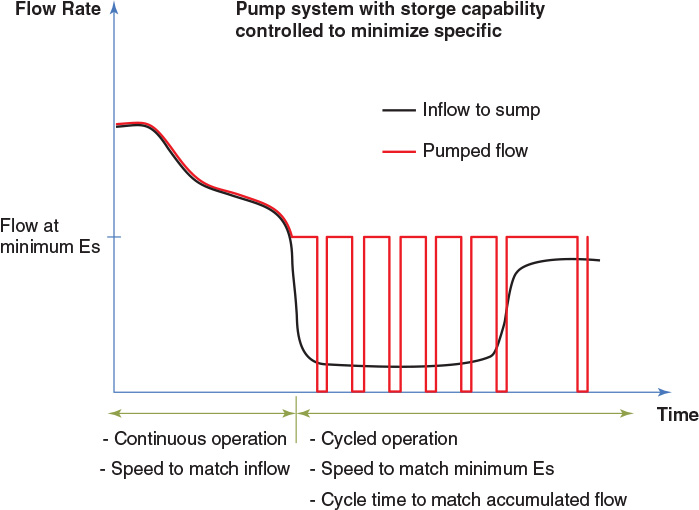
Es can be thought of analogous to gas mileage in cars (miles per gallon), but with pumps we use units of kilowatt-hour per cubic meter (kW-hr/m3) or kW-hr/gallon. Similar to your car, if you choose to drive slower (reduced pump speed), it will take you longer to get to your destination (pump operates longer to empty volume), but you will use less fuel (reduced pump power). A prime application for this is a lift station pump as shown in Figures 1 and 2. Figure 2 shows that when the in-flow is above the minimum Es flow, the pump will operate continuously, but when the in-flow is below the minimum Es flow, the pump will operate in on/off cycling, but at the speed where Es flow is minimized. This control method results in the minimum amount of energy consumption to meet the requirements of the in-flow.
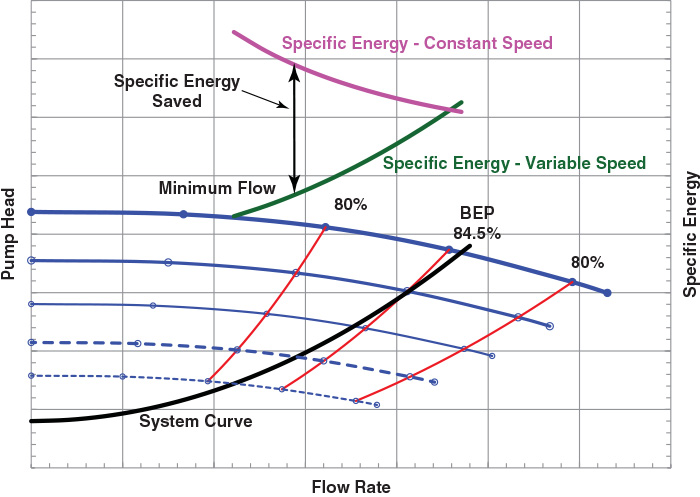
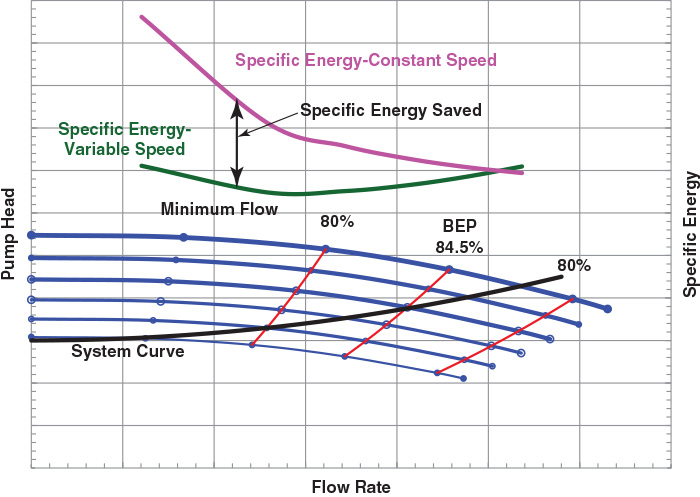
The energy savings in variable flow pumping systems are certain in systems dominated by friction losses, as shown in Figure 3, and can be illustrated by reviewing the Es as speed is reduced, which shows efficiency changes are minimized as speed is reduced. Therefore, Es consistently decreases with speed. On the other hand, in systems with more static head as shown in Figure 4, the pump efficiency is reduced more significantly at lower speeds, and at a certain point the Es begins to increase as speed is reduced. These examples show clearly the overall general principles that (1) for variable flow conditions, control by the use of a VSD is more efficient than using throttle control, and (2) the lower the static head in the system, the more energy can be saved.
There are several ways to vary the speed of a pump; however, the most common method is the use of variable frequency drives (VFDs). In addition to the energy savings mentioned, the use of VFDs provides additional benefits:
- precise process control
- power factor correction
- reduced inrush current
- reduced mechanical stress and reduced transients when starting and stopping
- advanced monitoring
- communication and protection
- improved reliability
On the other hand, there are general and operational drawbacks that arise when applying a VFD that can lead to reduced reliability (see Table 2). Table 2 is not comprehensive; please reference Application Guideline for Variable Speed Pumping for a full list. As noted in Table 2, VSP has a special set of requirements that must be considered during system and application selection, installation, operation and troubleshooting.
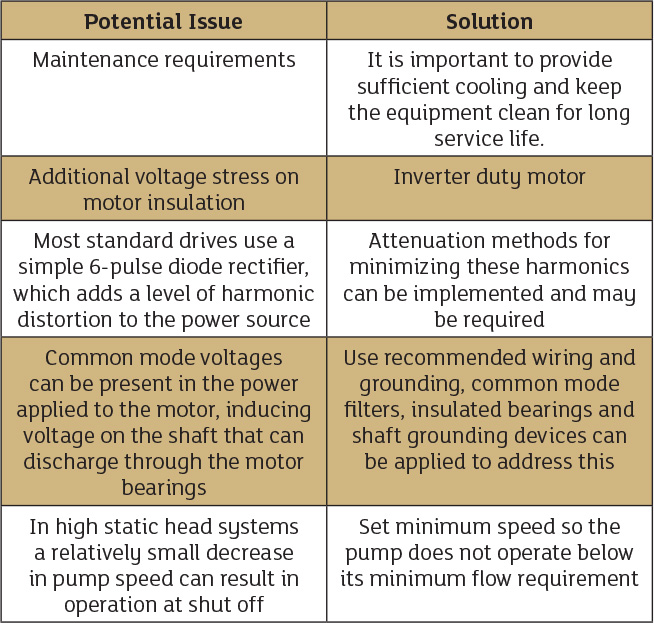
The ultimate goal of the guidebook is to educate the pumping industry and to ensure the safe, reliable and efficient operation of pumping equipment. This guidebook provides a comprehensive guide to VSP, including technical descriptions of pumping systems and their components, and guides the reader through the evaluation of different speed control options.
This guidebook also details troubleshooting information to help diagnose common issues with VSP systems. Case studies help illustrate the life cycle cost savings and process improvements that appropriate VSP can deliver. It combines the technical knowledge of pump, motor and control systems in one guide, bringing together all the concepts, metrics and step-by-step decision-making support needed to determine which VSP strategies are most appropriate.
This article was originally printed in Pump & Systems Magazine, 06/14/2017.
SUBSCRIBE TODAY
Get the latest pump industry news, insights, and analysis delivered to your inbox.
